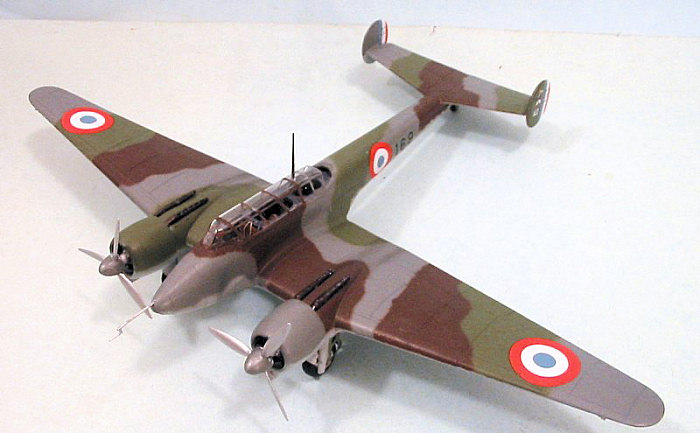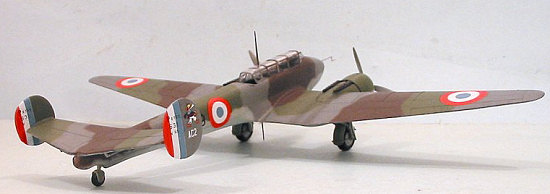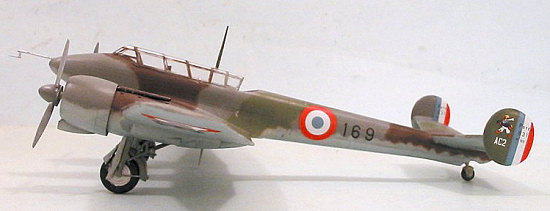
Azur 1/48 Potez 631
| KIT #: | ? |
| PRICE: | £23.00 from www.hannants.co.uk |
| DECALS: | Three options |
| REVIEWER: | Tom Cleaver |
| NOTES: | Short run with resin parts |

| HISTORY |
The Potez 63 was originally designed in answer to a French Air Ministry specification issued October 31, 1934, for a Multiplace legere de Defense, or light, multi-seat defensive aircraft. The specification called for an aircraft able to perform the roles of fighter control (three-seat C3) bomber escort; daylight interceptor (two-seat C2); and night-fighter (two-seat Cn2). The first prototype Potez 630 flew April 25, 1936. Ten more prototypes were tested before a production order was placed in 1937 for 80 Potez 630s, powered by two 580 h.p. Hispano-Suiza 14 radials, and 80 Potez 631s,powred by 670 h.p. Gnome-Rhone 14 Mars radials. A total of 702 production aircraft were built, including thee non-fighter versions. The Potez 633 B2, a light bomber version with a partially glazed nose ordered by Romania and Greece, though all but 21 were retained by France; the Potez 637 A3, a three-seat reconnaissance version with a ventral gondola for the observer; and the Potez 63-11 with an extensively redesigned fully glazed nose and a short crew canopy.
With a top speed of only 274 m.p.h., the Potez 631 suffered from the inability
of the French aircraft industry to produce high- powered
aircraft engines as the Germans and British had done. In the event, the only
German bomber the Potez 631 would outperform was the He-111,with both the Do-17
and the Ju-88 being able to outrun it.
powered
aircraft engines as the Germans and British had done. In the event, the only
German bomber the Potez 631 would outperform was the He-111,with both the Do-17
and the Ju-88 being able to outrun it.
As the outbreak of war, the Armee de l’Air had 80 Potez 630s and 206 Potez 631s, with 117 in first-line units. In February 1940, the severely-underpowered Potez 630s were converted into dual control multi-engine trainers, and it was decided to up the armament of the Potez 631 from 2 20mm cannon and 2 7.62mm machine guns in the nose with a 7.62mm machine gun in the rear for defense, by adding four additional 7.62mm weapons under the wings. In the event, only two Potez 631s would fly with this armament before the armistice.
Following the German attack on May 10,1940, the Potez 631s were unable to intercept any German bombers at night. The French high command decided to commit the Potez631s to ground-attack missions. The first, by 18 Potez 631s against Wehrmacht units near Fourmies, resulted in the loss of six to German flak. On May 18, a Potez 631 finally succeeded in shooting down a He-111. During the Battle of France, the Potez 631s of the Armee de l’Air managed to shoot down 4 confirmed and 8 probables, for a loss of 10 to enemy action.
The two Aeronavale units, based at Calais-Marck, Escadrilles AC1 and AC2 of Flottille F1C, had the greatest success, shooting down 12 German aircraft over the North Sea for a loss of 8 of their own.
 Called the French Me-110,
the Potez 631 suffered from its similarity to the German twin, and three were
shot down by their own side, in addition to several others being shot up.
Called the French Me-110,
the Potez 631 suffered from its similarity to the German twin, and three were
shot down by their own side, in addition to several others being shot up.
Following the Armistice, 112 Potez 631s were deployed to Vichy France, with another 53 based in North Africa. When the Germans occupied Vichy in November 1942, they took over 134 Potez 63s of all variants, several of which were sent on to the Rumanian Air Force. Three of these were recaptured in September 1944 by the FFI and used by GR III/33 on recon missions over the German strongholds in the Atlantic pocket over the remaining months of the war. These were used after the war at the Flight Research Center for rocket tests.
| THE KIT |
Azur has produced the Potez 631 in 1/72 scale, and this 1/48 kit is essentially a scale-up of that kit.
The parts fit is remarkably better than one normally associates with an MPM
product, as if some central group did all the design of the plastic and resin
parts. As  it turns out, the kit
was designed in France and produced by MPM. Test-fitting reveals that if one
cleans up all the parts, there will be very little fiddling in construction.
Sanding down the trailing edges of the wings before assembly will result in very
fine sharp surfaces. Overall, everything fits well.
it turns out, the kit
was designed in France and produced by MPM. Test-fitting reveals that if one
cleans up all the parts, there will be very little fiddling in construction.
Sanding down the trailing edges of the wings before assembly will result in very
fine sharp surfaces. Overall, everything fits well.
The two resin engines are beautiful molds, and cockpit has sufficient detail to look good under the long glass canopy.
Decals are provided for three Potez 631s, including one from Flotille F1C of the Aeronavale, the most successful unit during the Battle of France, one from an Armee de l’Air unit, and one from the Vichy Air Force with the “slave’s pajamas” markings of yellow and red stripes.
| CONSTRUCTION |
Overall, this is one of the best-designed Eastern European limited-run kits I
have had the pleasure to build. The fact it comes from MPM - a company that I
have frequently joked operates on the principle of “Fit? Fit? We don’t need no
stinking fit!” (to paraphrase a famous line from a famous movie) - is pleasantly
surprising. In the months since I built this model, I have had the opportunity
to look over other new MPM kits from Azure, Special Hobby and MPM itself, and it
appears that designing in good fit in the initial design is now a more
widespread policy. For that, I give MPM kudos.
I began construction by painting the cockpit and the various parts while still on their sprues. I then moved on and assembled the wings and tail subassemblies. I finished this part off by assembling and painting the very nice-looking resin engines, then assembling them in their cowlings and attaching them to the wings. I only needed Mr. Surfacer 500 on various joints and seams to end up with good-looking assemblies.
I do wish that MPM still provided vacuform canopies, despite the fact that those injection-molded canopies they are producing now are thin and beautifully clear. The problem is that a canopy like this one is impossible to cut and pose open, and the detail inside the cockpit - if all of it is used - cries out for open canopies so it can all be seen.
 With the fact in mind that
viewers would not be able to see all that much inside the cockpits with a closed
canopy, I left off a lot of the small photo-etch detail. I have seen another
model of this kit done, with a really beautifully-done cockpit using all the
detail provided, where the modeler vacuformed a canopy and then posed it open.
I would recommend this for anyone who wants to put the wealth of detail this kit
provides to its fullest display.
With the fact in mind that
viewers would not be able to see all that much inside the cockpits with a closed
canopy, I left off a lot of the small photo-etch detail. I have seen another
model of this kit done, with a really beautifully-done cockpit using all the
detail provided, where the modeler vacuformed a canopy and then posed it open.
I would recommend this for anyone who wants to put the wealth of detail this kit
provides to its fullest display.
Once the cockpit was assembled, I closed up the fuselage and proceeded to attach the wings and tail surfaces. These fit as well as all the other parts without a lot of modification and hassle. I then applied Mr. Surfacer 500 to the fuselage center line and the joints of the wing/fuselage attachment and the joints on the stabilizer.
After sanding down the Mr. Surfacer and rescribing where necessary, I used rubbing compound to insure a nice smooth surface overall and it was time for the paint shop.
| COLORS & MARKINGS |
 Painting:
Painting:
I used Xtracrylix paints throughout, applied freehand with my Paasche-H airbrush. The lower surface was painted with RLM76 Light Blue-Grey, while the upper surfaces were painted with RAF Ocean Grey, RLM62 Green, and Signal Braun. When this was all dry, I gave the model an overall coat of Xtracrylix Gloss Varnish.
Decals:
I used the kit decal option for the aircraft from Flotille F1C, the leading French Aeronavale unit to operate the Potez 631 during the Battle of France. The decals went on without problem under a coat of Micro-Scale.
| FINAL CONSTRUCTION |
After I attached the exhausts and the other various small parts, the model
received light exhaust staining done with Tamiya “Smoke” before I applied a coat
of Xtracrylix Flat Varnish. From the few photos o f
the Potez 631 in the Squadron “French Fighters in Action” book, it does not
appear that these airplanes were in combat use long enough to pick up many dings
or to be otherwise “weathered,” so I left the model clean overall. When all
this was done I unmasked the canopy and then attached the landing gear. It was
at this point I realized that the carpet monster had eaten the rear machine gun,
so the model awaits my discovery of something appropriate to replace that to be
really finally finished.
f
the Potez 631 in the Squadron “French Fighters in Action” book, it does not
appear that these airplanes were in combat use long enough to pick up many dings
or to be otherwise “weathered,” so I left the model clean overall. When all
this was done I unmasked the canopy and then attached the landing gear. It was
at this point I realized that the carpet monster had eaten the rear machine gun,
so the model awaits my discovery of something appropriate to replace that to be
really finally finished.
| CONCLUSIONS |
This is a very nice kit of a significant French fighter, and as such deserves a place in any representative collection of French aircraft of the Second World War. The kit is significantly better than most limited-run kits as regards design and production standards, and will result in a good-looking model.
March 2007
Review kit courtesy of Hannant’s. www.hannants.co.uk
If you would like your product reviewed fairly and quickly by a site that has over 350,000 visitors a month, please contact me or see other details in the Note to Contributors.